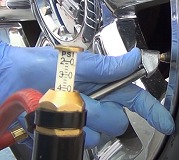We don't get involved with costs here because there's way too many variables, plus, we don't even know what is wrong yet.
Ford front-wheel-drive cars have more trouble with worn ball joints and tie rod ends separating than all other brands combined, so never ignore clunks and rattles. When those show up, have the steering and suspension systems inspected at a tire and alignment shop right away. Some of those noises come from things that are not safety issues, but you don't want to risk a broken part sending you into the ditch or oncoming traffic.
Based on your observation of the symptoms, a good guess is the coil spring broke and let that corner of the car drop down to where the inner fender is rubbing on the tire. The worse problem is it is common for the ends of the spring, where it broke, to be very sharp, and right in the area of where it can shift and poke a hole in the sidewall of that tire. A broken spring is an age issue, not a mileage one.
Alignment specialists get very picky about suspension ride height. If the coil springs are sagged from age, even though the numbers on the alignment computer look good for a car standing still on the alignment hoist, we know you'll have miserable tire wear if ride height isn't correct. Incorrect ride height changes the arcs the suspension parts go through as the car goes up and down over bumps in the road. That changes how the wheel leans in and out on top as the car bounces up and down.
We always want to correct ride height so we can do the best quality alignment for you. With almost all front-wheel-drive cars, that means installing new coil springs. To do that, we have to remove the entire strut/spring assembly, then take the spring off, which has a high degree of safety concerns. If the spring slips out of the spring compressor, it can kill a person since it's under high tension. I've seen them take out an overhead light fixture, and I saw one go sailing out of the shop, and through the parking lot. The spring is taken off the strut, but to say that a different way, you're doing a basic strut replacement job but putting the old struts back on. The mechanic is going through more work than just replacing the struts. That makes a "quick-strut" a much better deal for you and for the mechanic. Those are new struts with new springs, new upper mounts, (another fairly high-failure item), and new bounce cushions already put together as a bolt-on assembly. You'll pay only a little more for parts compared to just a pair of springs, but you'll pay a lot less in labor.
Ford is also famous for leaving off one of the most critical alignment adjustments on their front-wheel-drive cars, so the alignment consists of just setting the direction the two front wheels are steering. There's no adjustment available to correct how the wheels lean in or out on top. If that causes accelerated tire wear, you just keep buying new tires, but it makes the alignment procedure real quick and easy for the mechanic.
Saturday, August 10th, 2019 AT 1:33 PM




